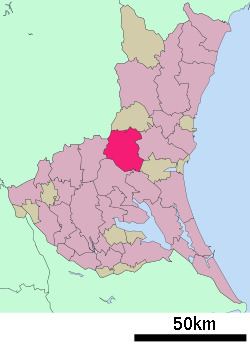Population 76,888 (Sep 2015) | Region Kantō - Tree Sakura Area 240.2 km² Local time Saturday 5:16 AM | |
 | ||
Weather -2°C, Wind N at 3 km/h, 78% Humidity | ||
Kasama (笠間市, Kasama-shi) is a city located in Ibaraki Prefecture, in the northern Kantō region of Japan. As of September 2015, the city had an estimated population of 76,888 and a population density of 320 persons per km². Its total area was 240.40 square kilometres (92.82 sq mi).
Contents
- Map of Kasama Ibaraki Prefecture Japan
- Geography
- Surrounding municipalities
- History
- Economy
- Education
- Railway
- Highway
- Local attractions
- Notable people from Kasama
- References
Map of Kasama, Ibaraki Prefecture, Japan
Geography
Kasama is located in the central Ibaraki Prefecture. Kasama is surrounded by mountains on all sides.
Surrounding municipalities
History
Kasama was once a castle town for Kasama Domain and post-station during the Edo Period, and a shrine town of Kasama Inari Shrine in the Meiji Period (1868–1912). Stone quarrying was its main activity. Utensils for tea ceremony, flower vases, and sake containers called Kasama ware were produced here. After the Meiji restoration, the town of Kasama was established with the creation of the municipalities system on April 1, 1889 within Nishiibaraki District. The town of Shishido, the former castle town of Shishido Domain was likewise established within Nishiibaraki District on the same day. In 1955, Shishido merged with the neighboring villages of Kitakawane and Ohara to form the town of Tomobe. Kasama was elevated to city status on August 1, 1958.
On March 19, 2006, Kasama absorbed the towns of Tomobe and Iwama (both from Nishiibaraki District), and the new city hall was located at the former Tomobe Town Hall. Tomobe became the new city's administrative center as it was more populous than the former Kasama.
The former town of Iwama is known for having been the residence of Ueshiba Morihei, founder of Aikido, from 1942 until his death. Popular singer and songwriter Sakamoto Kyu also lived in Kasama as a child. Twice daily, chimes announce the time to the tune of his songs. His song "Ue o muite arukō" also plays at Tomobe train station to announce departures.
Economy
Kasama has a mixed industrial base of light manufacturing and food processing. The main agricultural crops are rice and chestnuts. The area is also famous for stone quarrying of a form of granite called mikage-ishi, widely used in construction in Japan.
Education
Kasama has 11 elementary schools, six middle schools, and two high schools.
